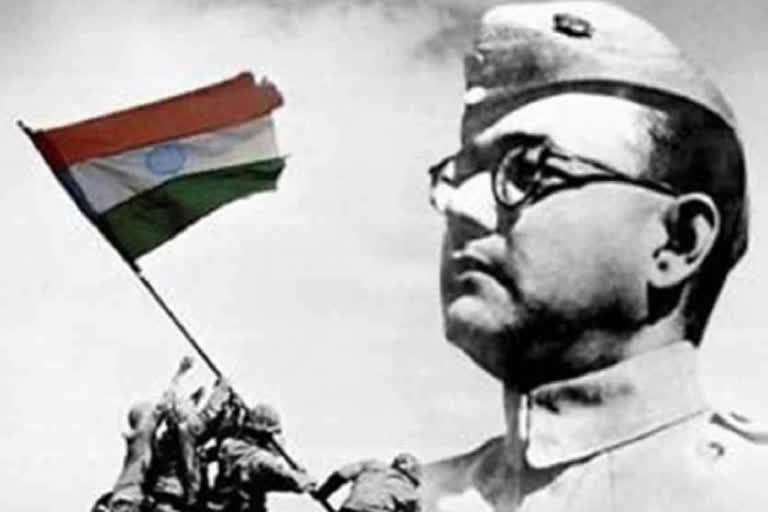Dehradun: 'You give me blood, I will give you freedom'... This slogan of Netaji Subhash Chandra Bose during the freedom struggle ignited the spark of desire for freedom in the hearts of revolutionaries.
There is hardly any citizen of the country who has not heard this slogan of Netaji.
This time the central government has decided to celebrate the birth anniversary of Netaji Subhash Chandra Bose, the founder of Azad Hind Fauj, as "Parakram Divas" (Bravery Day).
Devbhoomi Uttarakhand had a deep connection with Netaji’s Azad Hind Fauj that is written in history books.
There is also reference to Uttarakhand in this history. It is said that Netaji had spent some time in Dehradun disguised as a sadhu in 1977 though this has not been confirmed.
Netaji's fascination with Uttarakhand is also because he was inspired by Mahendra Pratap Singh, the king of Dehradun and Chandra Singh Garhwali, the hero of Peshawar episode while forming Azad Hind Fauj, after who two battalions of Garhwalis were included in Azad Hind Fauj.
Azad Hindi Government was formed in 1943
There are several facts related to the death of Netaji which have not yet come before the investigating agencies and inquiry commissions.
However, one cannot deny his Uttarakhand connection during his last fight while he was alive.
Netaji Subhash Chandra Bose had formed the Azad Hind Government on October 21, 1943, in Singapore after which its capital was shifted to Rangoon on January 7, 1944.
However, much before this, King Mahendra Pratap had formed a government in exile in Kabul in 1915 whose Prime Minister was Barkatullah.
Three commanders of Azad Hind Fauz were from Garhwal
Two battalions of Azad Hind Fauj were made of Garhwali officers and soldiers under the command of general Mohan Singh.
In the two battalions of Garhwal Rifles, 26 soldiers were recruited. Over 600 soldiers of this battalion were martyred in the battle against the British army.
Three commanders, Colonel Chandra Singh Negi, Colonel Buddhi Singh Rawat and Colonel Pitrisharan Ratudi were tasked to lead the Garhawali soldiers of the Garhwal Rifles.
Bose liked the Garhwali soldiers very much. This was the reason why he had chosen Major Buddhi Singh Rawat as the adjutant of his personal staff and Rateudi as the commandant of the Garhwal unit.
Similarly, Major Dev Singh Danu was deputed as the commander of the personal guard battalion.
The roles of other brave officers Lieutenant Gyan Singh Bisht, Captain Mahendra Singh Bagdi, Major Padma Singh Gusai and Major Dev Singh Danu were also very important.
Japan claimed his death in a plane crash
With the defeat of Japan in the Second World War, the Azad Hind Fauj too had to face defeat.
The British arrested the officers and soldiers of Azad Hind Fauj in 1945. The officers and soldiers of Azad Hind Fauj were tried in the Red Fort in Delhi in 1945.
The British mounted a hunt for Netaji Subhash Chandra Bose before the trial of the soldiers and officers of the Azad Hind Fauj.
Meanwhile, Japan announced on August 23, 1945, that Netaji had died in a plane crash on August 18, 1945.
Controversy still rages over Netaji’s death
Because of all types of statements over Netaji Subhash Chandra Bose’s death, there was widespread suspicion in the country after the Independence.
To let it rest the then Prime Minister Jawaharlal Nehru on December 3, 1955, appointed a three-member commission of inquiry comprising of Netaji’s close confidant Shahnawaz Khan, Netaji’s elder brother Suresh Chandra Bose and ICS officer N N Mitra.
Two members of the commission Shahnawaz Khan and NN Mitra held Japan’s version about Netaji’s death in a plane crash as true whereas Netaji’s elder brother Suresh Chandra Bose did not accept the Japanese version. Thereafter the controversy over Netaji’s death continues.
The mystery thickened after Gumnami Baba’s story
Several commissions were appointed to solve the mystery surrounding Netaji’s death.
In 1970, a commission headed by Justice GD Khosla was appointed followed by another in 1999 headed by Supreme Court judge Manoj Mukherjee.
Despite the mystery of Subhash Chandra Bose’s death remains unsolved. It was also claimed that Gumnami Baba was Netaji disguised as a sadhu. But there was no proof to support this claim. It was rumoured that Netaji, as Gumnaami Baba had spent his last years in Sholmari ashram on Rajpur Road of Dehradun.
However, the founder of the ashram Swami Sharadanand too could not support the claim.
Also Read: Russia claims no documents pertaining to Netaji's whereabouts



